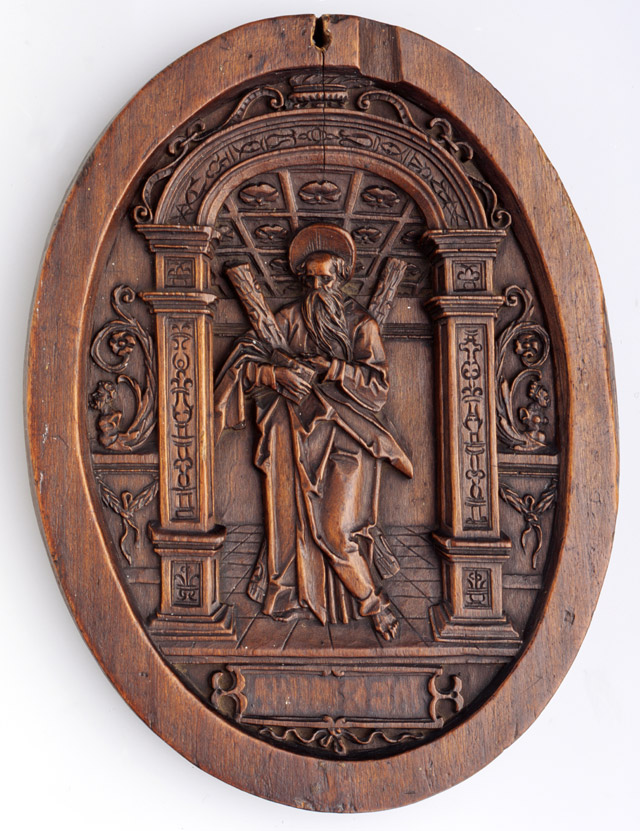Goldsmith's Model for a Reliquary in the Shape of the St. Andrew's Cross
Museum für Kunst und Gewerbe Hamburg

 Select the image to zoom
Select the image to zoom
The wooden relief with the representation of the Apostle Andrew carrying in his arms the cross on which he was martyred served as a model for a silver-gilt reliquary in the form of the St. Andrew's Cross. This reliquary originally belonged to the Archbishop of Magdeburg and Mainz, Cardinal Albrecht of Brandenburg (1490–1545) and formed part of the so-called "Hallesche Heiltum", a treasure of precious relics which exceeded in both quality and quantity anything which had gone before. The value of this collection of holy objects resided in the presumed authenticity of the venerable remains of saints, possessed of a virtue that had the power to promote the salvation of one's own soul, but also in the precious materials of the repositories in which they were housed. The public display of relics was celebrated annually with great pomp, a fact that was registered by contemporary observers with both fascination and admiration, but also began to draw increased criticism with the growing influence of Protestant reformers.
Cardinal Albrecht of Brandenburg continued to revere his "dear saints" up to the end of his life. The treasury of relics, built up with the collection of his predecessor Archbishop Ernst of Saxony (1476–1513) as its core, was transferred by the Cardinal in 1520 to the Neue Stift in Halle an der Saale. The collection eventually comprised 42 bodies of Saints and more than 8000 relic fragments, housed in over 350 exquisite reliquaries.
If we did not have the celebrated Codex in the Schloss- und Stiftsbibliothek of Aschaffenburg, which was produced in 1526/27 for Cardinal Albrecht as a sort of private catalogue of his relic collection, the knowledge concerning this sacred treasure, once so extensive, would only have come down to us in very attenuated form. For in the 1530s, Cardinal Albrecht, who had indebted himself to all and sundry, was forced to sell some of the treasure's most valuable items. After the introduction of the Reformation in Halle, Albrecht took the remaining reliquaries with him to Mainz and to his new residence at Aschaffenburg. Much was lost in the Thirty Years War and in the upheavals of the Napoleonic occupation. What was left is today scattered all around the world.
353 reliquaries are illustrated in colour in the Aschaffenburg codex, each with a brief description. The fragments contained in them are each enumerated in detail. The reliquary in the shape of the St. Andrew's Cross (fol. 205 v) is said to have been intended to house the shoulder-blade of the Apostle Andrew. Unfortunately the gilt reliquary itself, which was adorned with precious stones on the arms of the cross, has not survived. All the more important is the Hamburg relief in limewood, carved as a model for the chasing work of the representation of the apostle in the centre of the St. Andrew's Cross, and which formed the cover of the relic depository.
During the course of research, the goldsmith's model has been attributed to various artists. Hans Schwarz (1492–1532), Ludwig Krug (1489–1532) as well as, most recently, Peter Flötner (1485–1546) have all been suggested as its possible creators. A coat-of-arms burnt into the rear, depicting a tower, probably an indelible inventory stamp of a private collection, points to the coat-of-arms of the Nuremberg patrician family of the Harsdorfers. The fact that the relief belonged to the collection of a family of Nuremberg patricians lends credence to the presumption that both the model and the goldsmith's work of art came from Nuremberg.
Goldsmith's models from the early 16th century were highly esteemed treasures in the Kunstkammer of the late 16th and 17th centuries. The echoes of Italian or indeed Augsburg Renaissance forms in the use of perspective and space in the representation, reminiscences of Hans Burgkmair's woodcuts, as well as a style in the depiction of the human figure inspired by Albrecht Dürer make this a most attractive work of art.




